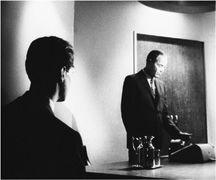B0041VYHGW EBOK (53 page)
Authors: David Bordwell,Kristin Thompson

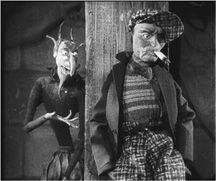
4.85 Ladislav Starevich’s puppet film
The Mascot
includes a conversation between a devil and a thief, with subtle facial expressions and gestures created through animation.
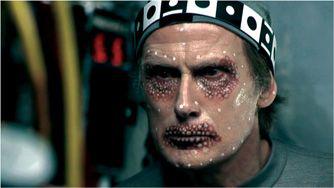
4.86
Pirates of the Caribbean: Dead Man’s Chest
: Along with makeup around his eyes and mouth, actor Bill Nighy had white motion-capture dots applied to his face. His facial expressions were used to create virtual makeup, including a beard made of writhing tentacles, for his character, Davy Jones.
Although abstract shapes and animated figures can become important in the mise-en-scene, the most intuitively familiar cases of figure expression and movement are actors playing roles. Like other aspects of mise-en-scene, the performance is created in order to be filmed. An actor’s performance consists of visual elements (appearance, gestures, facial expressions) and sound (voice, effects). At times, of course, an actor may contribute only visual aspects, as in silent movies. Similarly, an actor’s performance may sometimes exist only on the sound track of the film; in
A Letter to Three Wives,
Celeste Holm’s character, Addie Ross, speaks a narration over the images but never appears on the screen.
Acting is often approached as a question of realism. But concepts of realistic acting have changed over film history. Today we may think that the performance of Hilary Swank in
Boys Don’t Cry
or those given by Heath Ledger and Jake Gyllenhaal in
Brokeback Mountain
are reasonably close to people’s real-life behavior. Yet in the early 1950s, the New York Actors Studio style, as exemplified by Marlon Brando’s performances in
On the Waterfront
and
A Streetcar Named Desire,
was also thought to be extremely realistic. Fine though we may still find Brando’s work in these films, it seems deliberate, heightened, and quite unrealistic. The same might be said of the performances, by professional and amateur actors alike, in post–World War II Italian neorealist films. These were hailed when they first appeared as almost documentary depictions of Italian life, but many of them now seem to us to contain polished performances suitable to Hollywood films. Already, major naturalistic performances of the 1970s, such as Robert De Niro’s protagonist in
Taxi Driver,
seem quite stylized. Who can say what the acting in
The Insider, In the Bedroom, Frozen River,
and other films will look like in a few decades?
CONNECT TO THE BLOG
It’s not easy to analyze film acting. We consider how it might be done and link to some close analyses of silent-film acting in “Acting up.”
“I get impatient with many Hollywood films because there’s this assumption that meaning or emotion is contained in those few square inches of an actor’s face and I just don’t see it that way at all. I think there’s a power in withholding information, revealing things gradually. Letting the audience discover things within the frame in time, in the way they stand.”
— Alison Maclean, director,
Crush
Changing views of realism are not the only reason to be wary of this as a concept for analyzing acting. Often, when people call a performance unrealistic, they are evaluating it as bad. But not all films try to achieve realism. Since the performance an actor creates is part of the overall mise-en-scene, films contain a wide variety of acting styles. Instead of assuming that acting must be realistic, we should try to understand what kind of acting style the film is aiming at. If the functions of acting in the film are best served by a nonrealistic performance, that is the kind that the skillful actor will strive to present. Obvious examples of nonrealistic acting style can be found in
The Wizard of Oz,
for fantasy purposes. (How would a real Wicked Witch behave?) Moreover, realistic performance will always be only one option in film acting. In mass-production filmmaking from Hollywood, India, Hong Kong, and other traditions, overblown performances are a crucial source of the audience’s pleasure. Viewers do not expect narrowly realistic acting from Jim Carrey or from martial-arts stars such as Jet Li and Jackie Chan.
Finally, when we watch any fictional film, we are to some degree aware that the performances on the screen are the result of the actors’ skills and decisions. (See
“A Closer Look.”
) When we use the phrase “larger than life” to describe an effective performance, we seem to be tacitly acknowledging the actor’s deliberate craft. In analyzing a particular film, it is usually necessary to go beyond assumptions about realism and consider the functions and purposes that the actor’s craft serves.
In 1985, Hollywood observers were surprised that Steve Martin wasn’t nominated for an Academy Award for
All of Me.
In that film, Martin portrays a man whose body is suddenly inhabited on the right side by the soul of a woman who has just died. Martin used sudden changes of voice, along with acrobatic pantomime, to suggest a split body. In 1999, a similar outcry occurred when Jim Carrey was not nominated for an Oscar for
The Truman Show,
a comedy about a man who is unaware that his entire life has been broadcast as a sitcom on television. Neither Martin nor Carrey could be expected to perform realistically in the narrow sense of the word, since the situations they portray could not exist in the real world. Yet in these fantasy-comedies, the performances are completely appropriate.
In films like
All of Me
and
The Truman Show,
a more muted and superficially realistic performance would clearly be inappropriate to the context established by the genre, the film’s narrative, and the overall mise-en-scene. This suggests that a performance, realistic or not, should be examined according to its
function
in the context of the film.
We can consider performance along two dimensions. A performance will be more or less
individualized,
and it will be more or less
stylized.
Often we have both in mind when we think of a realistic performance: it creates a unique character, and it does not seem too exaggerated or too underplayed. Marlon Brando’s portrayal of Don Vito Corleone in
The Godfather
is quite individualized. Brando gives the Godfather a complex psychology, a distinctive appearance and voice, and a string of facial expressions and gestures that make him significantly different from the standard image of a gang boss. As for stylization, Brando keeps Don Vito in the middle range. His performance is neither flat nor flamboyant; he isn’t impassive, but he doesn’t chew the scenery either.
Yet this middle range, which we often identify with realistic performance, isn’t the only option. On the individuality scale, films may create broader, more anonymous
types.
Classical Hollywood narrative was built on ideologically stereotyped roles: the Irish cop on the beat, the black servant, the Jewish pawnbroker, the wisecracking waitress or showgirl. Through
typecasting,
actors were selected and directed to conform to type. Often, however, skillful performers gave these conventions a freshness and vividness. In the Soviet cinema of the 1920s, several directors used a similar principle, called
typage.
Here the actor was expected to portray a typical representative of a social class or historical movement
(
4.97
,
4.98
).

4.97 The opening of Sergei Eisenstein’s
Strike
presents the cartoonish cliché of the top-hatted capitalist …
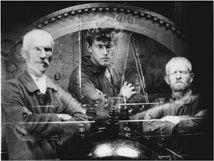
4.98 … while in contrast the workers are later presented as earnest and resolute.
A CLOSER LOOK
THE FILM ACTOR’S TOOLKIT
We might think that the most important task facing an actor is speaking dialogue in a convincing and stirring way. Certainly, voice and delivery are very important in cinema, but considered in terms of mise-en-scene, the actor is always part of the overall visual design. Many film scenes contain little or no dialogue, but at every moment onscreen, the actor must be in character. The actor and director shape the performance pictorially.
At all times, film actors use their faces. This was most evident before movies had sound, and theorists of the silent film were full of praise for the subtle facial acting of Charlie Chaplin, Greta Garbo, and Lillian Gish. Since some basic facial expressions (happiness, fear, anger) are understood easily across cultures, it’s not surprising that silent films could become popular around the world. Today, with mainstream fiction films using many close-ups (see
p. 195
), actors’ faces are hugely enlarged, and the performers must control their expressions minutely.
The most expressive parts of the face are the mouth, eyebrows, and eyes. All work together to signal how the character is responding to the dramatic situation. In
Jerry Maguire,
the accountant Dorothy Boyd accidentally meets Jerry at an airport baggage conveyor. She has a crush on him, partly because she admires the courageous mission statement he has issued to the sports agency they work for. As he starts to back off from the statement, she eagerly quotes it from memory; Renee Zellwegger’s earnest smile and steady gaze suggest that she takes the issues more seriously than Jerry does
(
4.87
).
This impression is confirmed when Jerry says, “Uh-huh,” and studies her skeptically, his fixed smile signaling social politeness rather than genuine pride
(
4.88
).
This encounter sets up one premise of the film—that Jerry’s idealistic impulses will need constant shoring up, for he might at any moment slip back into being “a shark in a suit.”
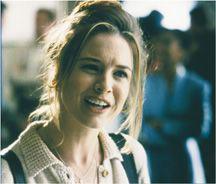
4.87 Perky and sincere, Dorothy pledges allegiance to Jerry Maguire’s idealistic memo.
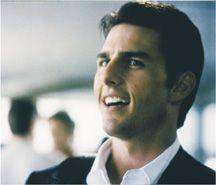
4.88 Jerry smiles politely, but his sideways glance and brows suggest that he is a bit put off by her earnestness.
The eyes hold a special place in film. In any scene, crucial story information is conveyed by the direction of a character’s glance, the use of eyelids, and the shape of the eyebrows. One of Chaplin’s most heartrending moments comes in
City Lights,
when the blind flower girl, now sighted, suddenly realizes that he’s her benefactor. Chaplin twirls a flower in his teeth, so we can’t see the shape of his mouth; we must read yearning in his brows and rapt, dark gaze
(
4.89
).
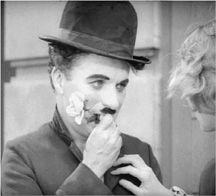
4.89 In the climax of
City Lights,
by concealing his mouth with the flower he twirls nervously, Chaplin obliges us to find his hope expressed in the upper part of his face.
Normally, we don’t stare intently at the people we talk with. We glance away about half the time to gather our thoughts, and we blink 10–12 times a minute. But actors must learn to look directly at each other, locking eyes and seldom blinking. If an actor glances away from the partner in the conversation, it suggests distraction or evasion. If an actor blinks, it suggests a reaction to what is happening in the scene (surprise, or anxiety). Actors playing forceful characters often stare fixedly. Anthony Hopkins said this of playing Hannibal Lecter: “If you don’t blink you can keep the audience mesmerized.” (See
8.3
,
8.5
.) In our
Jerry Maguire
scene, the protagonists watch each other fixedly. When Jerry does close his eyes in response to Dorothy’s praise, it indicates his nervousness about confronting the issues that his mission statement raised.
Actors act with their bodies as well. How a character walks, stands, or sits conveys a great deal about personality and attitude. In fact, during the 18th and 19th centuries,
attitude
was used to refer to the way a person stood. Stage acting gave early film a repertoire of postures that could express a character’s state of mind. In the 1916 Italian film
Tigre Reale
(
The Royal Tigress
), the diva Pina Menichelli plays a countess with a shady past. At one point, she confesses this in a florid attitude that expresses noble suffering
(
4.90
).
While few actors today would resort to this stylized posture, early film audiences would have accepted it as vividly expressive, like a movement in dance. Menichelli plays the rest of the scene more quietly, but she still employs expressive attitudes
(
4.91
,
4.92
).
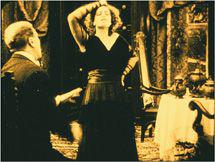
4.90 In
Tigre Reale,
Menichelli’s right hand seizes her hair, as if pulling her head back in agony; but her body still expresses defiance, thrust forward and standing firm as the left hand grips her waist.
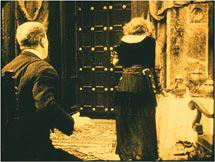
4.91 As Menichelli begins to feel shame, she retreats toward the fireplace, turning from us and slumping in a way that suggests regret.
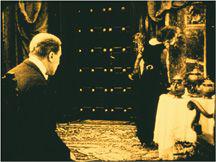
4.92 She keeps her back to the camera as she withdraws, now a pathetic figure.
Chaplin’s and Menichelli’s gestures show that hands are important tools of the film actor. Hands are to the body what eyes are to the face: They focus our attention and evoke the character’s thoughts and feelings. Actress Maureen O’Hara said of Henry Fonda, “All he had to do was wag his little finger and he could steal a scene from anybody.” A good example can be seen in the doomsday thriller
Fail-Safe.
Henry Fonda plays the U.S. president, who has learned that an American warplane has been accidentally sent to bomb the Soviet Union. Fonda stands erect at the phone as he hears distressing news about the plane’s progress, and he hangs up with his left hand
(
4.93
–
4.96
).
By keeping most of the shot still and bare, director Sidney Lumet has given Fonda’s fingers the main role, letting them express the president’s measured prudence but also suggesting the strain of the crisis.
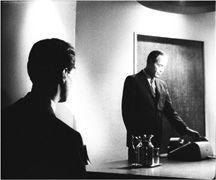
4.93 In
Fail-Safe,
the president stands erect at the phone as he hears distressing news about the plane’s progress, and he hangs up with his left hand.
